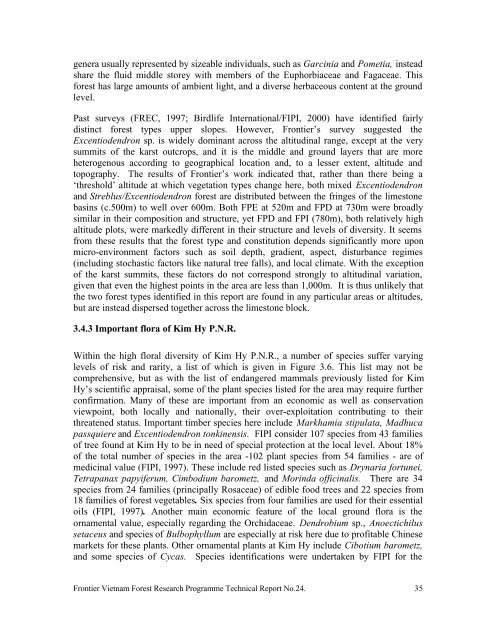Kim Hy Proposed Nature Reserve - Frontier-publications.co.uk
Kim Hy Proposed Nature Reserve - Frontier-publications.co.uk
Kim Hy Proposed Nature Reserve - Frontier-publications.co.uk
Create successful ePaper yourself
Turn your PDF publications into a flip-book with our unique Google optimized e-Paper software.
genera usually represented by sizeable individuals, such as Garcinia and Pometia, instead<br />
share the fluid middle storey with members of the Euphorbiaceae and Fagaceae. This<br />
forest has large amounts of ambient light, and a diverse herbaceous <strong>co</strong>ntent at the ground<br />
level.<br />
Past surveys (FREC, 1997; Birdlife International/FIPI, 2000) have identified fairly<br />
distinct forest types upper slopes. However, <strong>Frontier</strong>’s survey suggested the<br />
Excentiodendron sp. is widely dominant across the altitudinal range, except at the very<br />
summits of the karst outcrops, and it is the middle and ground layers that are more<br />
heterogenous ac<strong>co</strong>rding to geographical location and, to a lesser extent, altitude and<br />
topography. The results of <strong>Frontier</strong>’s work indicated that, rather than there being a<br />
‘threshold’ altitude at which vegetation types change here, both mixed Excentiodendron<br />
and Streblus/Excentiodendron forest are distributed between the fringes of the limestone<br />
basins (c.500m) to well over 600m. Both FPE at 520m and FPD at 730m were broadly<br />
similar in their <strong>co</strong>mposition and structure, yet FPD and FPI (780m), both relatively high<br />
altitude plots, were markedly different in their structure and levels of diversity. It seems<br />
from these results that the forest type and <strong>co</strong>nstitution depends significantly more upon<br />
micro-environment factors such as soil depth, gradient, aspect, disturbance regimes<br />
(including stochastic factors like natural tree falls), and local climate. With the exception<br />
of the karst summits, these factors do not <strong>co</strong>rrespond strongly to altitudinal variation,<br />
given that even the highest points in the area are less than 1,000m. It is thus unlikely that<br />
the two forest types identified in this report are found in any particular areas or altitudes,<br />
but are instead dispersed together across the limestone block.<br />
3.4.3 Important flora of <strong>Kim</strong> <strong>Hy</strong> P.N.R.<br />
Within the high floral diversity of <strong>Kim</strong> <strong>Hy</strong> P.N.R., a number of species suffer varying<br />
levels of risk and rarity, a list of which is given in Figure 3.6. This list may not be<br />
<strong>co</strong>mprehensive, but as with the list of endangered mammals previously listed for <strong>Kim</strong><br />
<strong>Hy</strong>’s scientific appraisal, some of the plant species listed for the area may require further<br />
<strong>co</strong>nfirmation. Many of these are important from an e<strong>co</strong>nomic as well as <strong>co</strong>nservation<br />
viewpoint, both locally and nationally, their over-exploitation <strong>co</strong>ntributing to their<br />
threatened status. Important timber species here include Markhamia stipulata, Madhuca<br />
passquiere and Excentiodendron tonkinensis. FIPI <strong>co</strong>nsider 107 species from 43 families<br />
of tree found at <strong>Kim</strong> <strong>Hy</strong> to be in need of special protection at the local level. About 18%<br />
of the total number of species in the area -102 plant species from 54 families - are of<br />
medicinal value (FIPI, 1997). These include red listed species such as Drynaria fortunei,<br />
Tetrapanax papyiferum, Cimbodium barometz, and Morinda officinalis. There are 34<br />
species from 24 families (principally Rosaceae) of edible food trees and 22 species from<br />
18 families of forest vegetables. Six species from four families are used for their essential<br />
oils (FIPI, 1997). Another main e<strong>co</strong>nomic feature of the local ground flora is the<br />
ornamental value, especially regarding the Orchidaceae. Dendrobium sp., Anoectichilus<br />
setaceus and species of Bulbophyllum are especially at risk here due to profitable Chinese<br />
markets for these plants. Other ornamental plants at <strong>Kim</strong> <strong>Hy</strong> include Cibotium barometz,<br />
and some species of Cycas. Species identifications were undertaken by FIPI for the<br />
<strong>Frontier</strong> Vietnam Forest Research Programme Technical Report No.24. 35
















